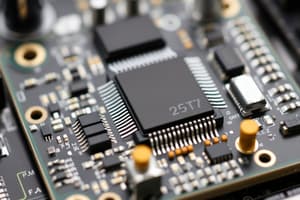Podcast
Questions and Answers
Which of the following is true regarding an embedded system?
Which of the following is true regarding an embedded system?
- It is designed to perform a specific task. (correct)
- It does not require hardware components.
- It can operate without any software.
- It can only be part of a larger system.
An embedded system can be both an independent system and part of a larger system.
An embedded system can be both an independent system and part of a larger system.
True (A)
What are the three main components of an embedded system?
What are the three main components of an embedded system?
Hardware, application software, Real Time Operating System (RTOS)
An embedded system must perform certain tasks in ________ without any delay.
An embedded system must perform certain tasks in ________ without any delay.
Match the characteristics of embedded systems with their descriptions:
Match the characteristics of embedded systems with their descriptions:
What is an essential feature that an embedded system must have?
What is an essential feature that an embedded system must have?
Embedded systems require high power consumption to operate efficiently.
Embedded systems require high power consumption to operate efficiently.
What is the role of an actuator in an embedded system?
What is the role of an actuator in an embedded system?
The ______ converts the analog signal sent by the sensor into a digital signal.
The ______ converts the analog signal sent by the sensor into a digital signal.
Match the following components of an embedded system with their functions:
Match the following components of an embedded system with their functions:
Study Notes
Overview of Embedded Systems
- An embedded system comprises computer hardware and software integrated to perform specific tasks.
- It can operate independently or as part of a larger system.
- Typically uses microcontroller or microprocessor technology focused on particular application functions.
Components of Embedded Systems
- Hardware: Physical components of the system.
- Application Software: Program-specific to the embedded function.
- Real-Time Operating System (RTOS): Manages application software, schedules processes, and controls system latencies. Not always required for smaller systems.
Characteristics of Embedded Systems
- Single-Functioned: Designed to perform a specialized operation repeatedly (e.g., a pager).
- Tightly Constrained: Must fit size, cost, performance, and power constraints. Usually compact enough to fit on a single chip while processing data in real-time.
- Reactive and Real-Time: Able to react continually to environmental changes with real-time results (e.g., cruise control systems in cars).
- Microprocessor-Based: Primarily based on microprocessors or microcontrollers.
- Memory: Typically uses ROM for embedded software without needing secondary storage.
- Connected: Connects with peripherals for input and output.
- HW-SW Systems: Combines hardware for performance and software for flexibility and enhanced features.
Advantages of Embedded Systems
- Easily customizable for specific applications.
- Low power consumption, making them efficient.
- Cost-effective due to specialized design.
- Enhanced performance for designated tasks.
Disadvantages of Embedded Systems
- High development effort required for design and testing.
- Longer time to market due to complexity involved.
Basic Structure of an Embedded System
- Sensor: Measures physical quantities and converts them to electrical signals; stores data for processing.
- A-D Converter: Converts analog signals from sensors into digital form.
- Processor & ASICs: Core for processing data and storing results in memory.
- D-A Converter: Converts digital results back into analog form for output.
- Actuator: Compares expected outputs against actual outputs and stores results.
Processor Architecture in Embedded Systems
- Program Flow Control Unit (CU): Manages instruction fetching and execution flow.
- Execution Unit (EU): Executes instructions related to data transfer and processing.
Importance of Processors in Embedded Systems
- The processor acts as the core component, processing incoming data to produce appropriate outputs, making extensive knowledge of both microprocessors and microcontrollers essential for embedded system designers.
Studying That Suits You
Use AI to generate personalized quizzes and flashcards to suit your learning preferences.
Description
This quiz provides an overview of embedded systems, including their definitions, components, and functions. An embedded system is defined as a computer hardware system with software embedded in it, designed for specific tasks. Explore the intricacies of embedded systems and their applications in everyday technology.




